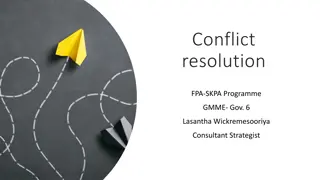Effective Conflict Resolution Strategies for Better Relationships
Explore various conflict resolution approaches such as accommodation, compromise, competition, collaboration, and win-win to address conflicts effectively. Learn how to manage issues, behaviors, and needs to maintain healthy relationships and achieve mutually beneficial solutions.
Download Presentation

Please find below an Image/Link to download the presentation.
The content on the website is provided AS IS for your information and personal use only. It may not be sold, licensed, or shared on other websites without obtaining consent from the author. Download presentation by click this link. If you encounter any issues during the download, it is possible that the publisher has removed the file from their server.
E N D
Presentation Transcript
Cant We Resolve This? Conflict Resolution 1
Safety BE SAFE 2
5 Major Categories of Human Need Safety Control Over Own Life Acceptance (to belong, be loved) Respect Economic Well-Being 3
Cycle of Conflict Party One Acts Party Two Interprets the Acts Negatively, Responds Party One Now Believing Needs Threatened 4
Approaches Use energy to avoid person or situation Advantages Time to cool Saves time When risks outweighs gains Avoidance Disadvantages Problem unresolved Relationship suffers Temporary 5
Approaches Accommodation Determine how to meet what other party needs. Advantage Help Continue Relationship one party may not have as strong a need as the other Disadvantage One Party s Needs Forfeited, possible resentment and negative spin-off Win/Lose 6
Compromise Energy used to determine how each party should change some behaviors to meet part of needs, so equitable loss and gain Advantage Both parties have some gains. Disadvantage Gains/losses may not be equitable 7
Competition Attack Other Party s Needs, Justify Own Behavior, Try to Coerce Other to Change Advantage One party wins in short run Disadvantage One party loses in short run Winning party may lose in long run, relationship weakened 8
Collaboration Parties work together to agree on some behavior modifications to address each other s needs, to try to get to win-win. Advantages Preserves relationships, avoids adversarial relationship Disadvantages - Personal investment of time, patience 9
Win-Win Example Issues with workloads Splitting you do this and I ll do that Trading Off I ll work 8-12 and you work 1-5 Alternating/sharing I ll use garage pass on Mondays and Wednesdays and you can use on Tuesdays and Thursdays Sweetening if you do this, you can take an afternoon off 10
Win-Win (cont.) Short-term Trial For the next month let s see if ______ will work well for all. Phasing In This month you can do this. Next month we ll add ____ and see how that works out. Conditional Agreement After you do this, I ll be willing to do that. 11
What can you do? Work to understand what the speaker is expressing, validate feelings Listen to words, view mannerisms Summarize, ask open-ended questions What happened? Identify the problem. Statements you were disrespectful , you are unreliable you think money grows on trees too vague What solutions would you suggest? Look for interest-based solutions. [ex: boss wants me to work late, but need to pick up kids by 6] Try putting yourself in other s shoes Reflect back the speaker s emotions, not just words 12
What can you do? (cont.) Compliment them Display receptive body language nodding head, leaning forward Square your body with the speaker Open arms and hands. Eye contact Relax body gestures Speak slowly, deep breathing Don t speak loudly Use silence 13
Process Prepare in Advance Take time to calm down before talking to others Think through what s happened. What behaviors concern each party What would you like to see the other party start or stop doing? What are you willing to start or stop doing? 14
Process (cont.) Consider time and location to discuss Private location Avoid distractions Allow enough time to explore issues and solutions 15
Process (cont.) Planning Meeting Consider who you will need to meet with, and if more than one, in what order. Let other party(ies) know you recognize a problem and want to try to reach a resolution acceptable to all. Establish agreeable time/place. Establish agreeable amount of time. 16
Process (cont.) Meeting Procedure Determine who is first person to describe concerns. If other parties, ask them if the order is okay. When other party done, summarize and ask questions (what problem behaviors have you done and perceived negative effects). When your turn, describe your view of what other party has done and its effect on you (emotional, monetary, etc.) Avoid vague or inflammatory descriptions, rightness or wrongness of behaviors. 17
Process (cont.) List issues (stated neutrally) and interests with regard to the issues. Deal with one issue at a time, ask parties to generate options what would they like the result to be? Look at interests Describe the resolution DETAILS, WHAT EACH PARTY WILL DO WHEN 18
Process (cont.) If no agreement, what happens next? 19
Sample Scenario You are an admin in the HR department. Your boss complains that a friend of yours, Justin, comes to work late, takes long lunches, leaves early, doesn t complete his work. She says that maybe it would be better if you talked to him as a friend. 20
Justin How and where will you approach him? Where would he like to meet? Discuss time period for discussion. When you go to talk to him, what human needs will he be thinking about? What is the employer willing to do? What would Justin be willing to do? 21























